The new La Terraza Rum & Lounge, in the former Acadia space in a Kavanaugh Boulevard office building in Little Rock's Hillcrest, is a mom and pop and son and daughter-in-law restaurant and bar, or is that a bar and restaurant? Venezuelan couple Carlos Valdivieso and Ana Lara transplanted a place they ran for two decades in Caracas, Venezuela; you can spot them coming in and out of the kitchen, with son and daughter-in-law co-owners Armando and Sarah Bolanos running the front of the house.
The signature Venezuelan sandwiches and other dishes on the menu are authentic, many of them accompanied by black beans, plantains and yucca. Other parts of the menu have a distinct Mediterranean accent, many of them stressing the links between the native Latin American cuisine and the contributions of the Spanish conquistadors, with a few Italian items and even a French contribution or two.
La Terraza Rum & Lounge
Address: 3000 Kavanaugh Blvd., Little Rock
Hours: 11 a.m.-1 a.m. Tuesday-Saturday, 10:30 a.m.-2:30 p.m. Sunday
Cuisine: South American/Mediterranean
Credit cards: V, MC, AE, D
Alcoholic beverages: Full bar, with more than two dozen rums
Reservations: Large parties
Wheelchair accessible: Yes, up a rather steep and lengthy ramp
Carryout: Yes
(501) 251-8261
tinyurl.com/laterra… (Facebook page)
The food is, on the whole, a bit blander than most other Central and South American fare we've tried, so if you like Latin American style but have found other cuisines too spicy, this will be an excellent option.
La Terraza's decor is not that different from Acadia's. The major change is the installation of a large bar, emphasizing the change from an upscale dining room to, as you might expect from the first part of its name, a rum bar with a Venezuelan kitchen. Armando Bolanos, who tends it (among his many other duties), has about 30 rums -- dark, light, fresh, aged (brand names include several varieties and ages of Bacardi, Don Q and Abuelo). The top-shelf rums are, in fact, on the top shelf.
The cocktail menu includes a lot of rum-based drinks. (Our mojito was enjoyable enough to order a second; we passed on the spicy mojito because we thought it might interfere with the flavor of our food. We watched other folks order and enjoy Cuba libres -- in fact, they specifically ordered a round of Cuba libres each to be made with a different type of rum.)
The sturdy acrylic-coated tables and chairs have been rearranged to open up the small dining room a bit (there's seating for about 40) and to take better advantage of the pin-spot lighting so there are fewer "dark" tables. Abstract for-sale oil paintings by a Venezuelan artist named Jimenez, nicely colorful and many with a similar sinuous theme, hang on the newly earth-toned walls and in the recesses that the Acadia's owners had used to show off wine bottles. There's a huge parmesan wheel on a table, symbolizing several dishes that feature the cheese among their ingredients, up to and including the Fettucine a la Rotonda ($20), in a house Alfredo sauce, "finished tableside in a wheel of parmesan." La Terraza also inherited Acadia's charming outdoor deck.
We went almost entirely Venezuelan for lunch with the arepas ($8), cornmeal pocket sandwiches (similar, if you're familiar with them, to the Mexican gordita and the Central American pupusa), stuffed with meat mixtures and served in a specially designed plastic holder to keep them upright, plus side black beans and lengthwise strips of lightly fried plantains.
Our Arepa Reina Pepiada wasn't quite what we were expecting; the shredded chicken in a blend of avocado and a housemade mayonnaise/mustard was essentially a glorified chicken salad, until we perked it up with side garnishes (a very spicy pepper mixture and a tangy oil-and-vinaigrette).
We were better impressed with the Carne Mechada, shredded beef braised in a red pepper-tomato broth that turns out to be the same meat as is in the dinner-menu Parbellon ($16), which we enjoyed on another visit. That's the "national dish of Venezuela," the flavorful meat taking up a quarter of the plate with the other three quarters occupied by white rice, black beans and plantain strips. Other arepa options: Pernil (a thinly sliced baked pork) and turkey and Manchego, a sheep-milk cheese.
The black beans are tasty but unlike other Latin American versions, they're kind of plain and not very exciting. The plantain is a relative of the banana, and the somewhat chewy strips are just sweet enough to give each dish a nice "sweetness" dimension.
Try as an appetizer the half-dozen or so Mini Arepas ($6), cheesy discs about the diameter of a half-dollar (do they still make half-dollars?) and about a quarter of an inch thick at the middle. They reminded us a little of the manioc-flour Pao de Queijo at nearby Cafe Bossa Nova.
We can also recommend the very Venezuelan Quesillo ($5) for dessert, a sort of combination custard-cheesecake with the best textural attributes of both, not too sweet and with a distinct smoky flan flavor.
We weren't able to try the Mediterranean signature dish in which we were most interested, the Paella ($43), Spanish-style rice with chicken, calamari, clams, mussels, scallops and shrimp, because:
a) It's for a minimum of two people, which means a party of two or more has to coordinate their taste buds and form a common purpose and be prepared to shun all the other attractive menu offerings, and
b) Because it takes 40 minutes to prepare, so you'll have to either set aside an entire evening for dinner or call in and order in advance. (Same restrictions apply to the $26 Mushroom Risotto.)
But we very much enjoyed:
• The Spanish Garlic Mushrooms ($9), fresh mushroom slices sauteed with olive oil and garlic, just available for some reason as a lunch appetizer, but well worth offending your co-workers with the ensuing garlic breath.
• The French Onion Soup ($9), a slightly nontraditional version with, instead of gruyere melted into a cap over the bowl, grated parmesan melted partially onto the floating crouton but also into the slightly tangy broth, giving it a somewhat creamy texture and flavor.
• The Beef Tenderloin Carpaccio ($13), a generous portion of as tasty a thin-sliced, seasoned beef as we have ever sampled, but almost overwhelmed with too many, too-thick beefy fresh mushroom slices, all drizzled with a nicely complementary basil aioli.
• Linguine Fruto di Mare ($21), a goodly quantity of calamari (which practically melted, butter-like, in our mouths, and as you know, calamari rings overcooked should be better employed as tiny tires), clams, mussels and scallops over almost al dente pasta in a tomato-white wine sauce. (A similar seafood admixture is available, in a tomato broth, over white rice, in the Spanish-sounding Zarzuela de Mariscos, $22, and the Sopa de Mariscos soup, $11. Somewhere down the line we will have to try the Linguine al Neri de Seppia, also $22, squid-ink pasta with calamari, garlic and basil in a tomato sauce.)
Armando Bolanos is a most charming host and explicator, but he does tend to hover a little. Service otherwise was generally very good over several visits, except for the early part of our Halloween-night meal. While the owners were out trick-or-treating with their wee daughter, the place got a little busy earlier than expected, the sole server was having to cope with several tables while doubling as bartender, and the building owner was substituting as seating host.
Weekend on 11/12/2015

